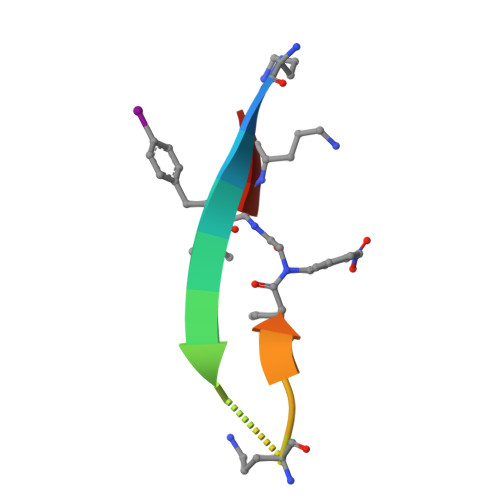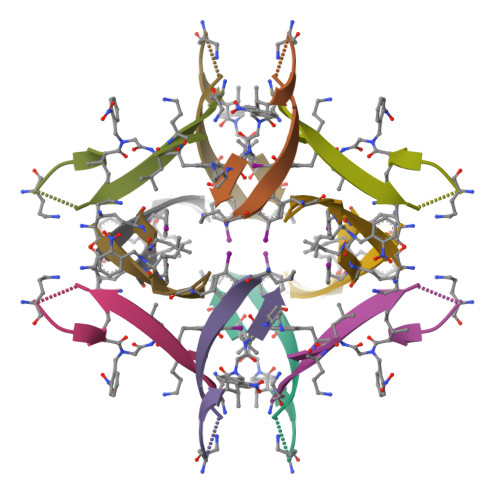Controlling the Oligomerization State of A beta-Derived Peptides with Light.
Salveson, P.J., Haerianardakani, S., Thuy-Boun, A., Kreutzer, A.G., Nowick, J.S.(2018) J Am Chem Soc 140: 5842-5852
- PubMed: 29627987
- DOI: https://doi.org/10.1021/jacs.8b02658
- Primary Citation of Related Structures:
6CG3, 6CG4, 6CG5 - PubMed Abstract:
A key challenge in studying the biological and biophysical properties of amyloid-forming peptides is that they assemble to form heterogeneous mixtures of soluble oligomers and insoluble fibrils. Photolabile protecting groups have emerged as tools to control the properties of biomolecules with light. Blocking intermolecular hydrogen bonds that stabilize amyloid oligomers provides a general strategy to control the biological and biophysical properties of amyloid-forming peptides. In this paper we describe the design, synthesis, and characterization of macrocyclic β-hairpin peptides that are derived from amyloidogenic peptides and contain the N-2-nitrobenzyl photolabile protecting group. Each peptide contains two heptapeptide segments from Aβ 16-36 or Aβ 17-36 constrained into β-hairpins. The N-2-nitrobenzyl group is appended to the amide backbone of Gly 33 to disrupt the oligomerization of the peptides by disrupting intermolecular hydrogen bonds. X-ray crystallography reveals that N-2-nitrobenzyl groups can either block assembly into discrete oligomers or permit formation of trimers, hexamers, and dodecamers. Photolysis of the N-2-nitrobenzyl groups with long-wave UV light unmasks the amide backbone and alters the assembly and the biological properties of the macrocyclic β-hairpin peptides. SDS-PAGE studies show that removing the N-2-nitrobenzyl groups alters the assembly of the peptides. MTT conversion and LDH release assays show that decaging the peptides induces cytotoxicity. Circular dichroism studies and dye leakage assays with liposomes reveal that decaging modulates interactions of the peptides with lipid bilayers. Collectively, these studies demonstrate that incorporating N-2-nitrobenzyl groups into macrocyclic β-hairpin peptides provides a new strategy to probe the structures and the biological properties of amyloid oligomers.
- Department of Chemistry , University of California, Irvine , Irvine , California 92697-2025 , United States.
Organizational Affiliation:




















